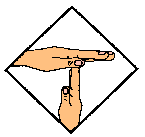In the late 1980's we researched and developed a series of seven messages and simple signals to convey these messages. The following graphical representations and narratives describe each of these messages and its accompanying signal. It is our hope and intention that they become known and used by all motorist.
 In a brief lapse of attention or judgment you unintentionally inconvenience,
irritate, or endanger another motorist. You feel embarrassed and the other
driver is angry. Neither state of mind produces safe, courteous driving
In a brief lapse of attention or judgment you unintentionally inconvenience,
irritate, or endanger another motorist. You feel embarrassed and the other
driver is angry. Neither state of mind produces safe, courteous driving
The "Apology" signal can diffuse the destructive anger and frustration that
follow these unfortunate encounters. To signal an apology, hold two fingers
in a "V" position, palm out.
 You see an obstacle in the road and would like to alert other motorists to
the potential danger. The "Slow Down" signal will warn others of an accident,
obstacle, or any dangerous condition.
You see an obstacle in the road and would like to alert other motorists to
the potential danger. The "Slow Down" signal will warn others of an accident,
obstacle, or any dangerous condition.
To alert traffic approaching from the opposite direction, turn your headlights off and on. To alert traffic approaching from the rear, activate your brake lights or extend your left arm and motion downward.
If you see the "Slow Down" signal from another motorist, heed the warning.
 While traveling on a multilane highway you wish to pass another vehicle
that is in the left "passing" lane. The "Lane Courtesy" signal will alert
the other motorist of your intention.
While traveling on a multilane highway you wish to pass another vehicle
that is in the left "passing" lane. The "Lane Courtesy" signal will alert
the other motorist of your intention.
Signal your intention by turning the left directional light on and off, 4 to 6 blinks at a time. If the slower vehicle does not respond to the left turn signal, briefly flash your headlights to gain the attention of the other driver.
If you see the "Lane Courtesy" signal from the motorist behind you, check
the adjacent right lane, pull over when it is safe to do so, and let the
faster vehicle pass.
 You come across a vehicle about to have a flat, or lose luggage from an outside
rack or litter the highway with skis, bicycles or furniture. The "Pull Over
For Problem" signal helps you alert the other driver.
You come across a vehicle about to have a flat, or lose luggage from an outside
rack or litter the highway with skis, bicycles or furniture. The "Pull Over
For Problem" signal helps you alert the other driver.
To alert another motorist of a problem with his or her vehicle, first point in the direction of the problem (up for loose roof rack, back for trailer problem, etc.), then signal "thumbs down."
If you receive this signal from another motorist, pull over and check your
vehicle.
 The directional lights on another vehicle have been unknowingly left on.
You see a vehicle with a burned out headlight or taillight. You would
like to alert the other driver of the problem.
The directional lights on another vehicle have been unknowingly left on.
You see a vehicle with a burned out headlight or taillight. You would
like to alert the other driver of the problem.
To signal a motorist to "check your lights." open and close your hand
touching the thumb and finger tips together.
 You are pulled over to the side of the road and need help. Most passersby
are unsure what help, if any, is needed. You need to signal for help without
conveying panic.
You are pulled over to the side of the road and need help. Most passersby
are unsure what help, if any, is needed. You need to signal for help without
conveying panic.
To signal for assistance, make the sign of a "T" by crossing one hand above the other.
If you see the "Need Assistance" signal, you must make a decision whether you
will stop, phone for help, or ignore the appeal.
 To acknowledge another motorist's signal...an apology light problem or problem
pull-over signal, for example, or to thank another driver for courtesy, use the
well-understood "Thumbs up" or "OK."
To acknowledge another motorist's signal...an apology light problem or problem
pull-over signal, for example, or to thank another driver for courtesy, use the
well-understood "Thumbs up" or "OK."